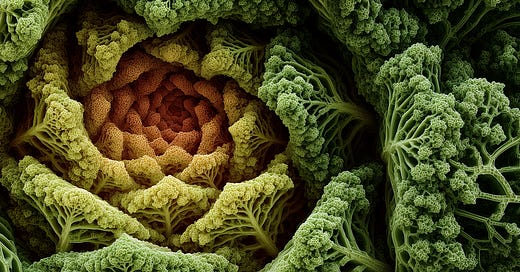One of the things I—and many others—struggle with is coming up with a concrete definition of what regenerative agriculture is. For years, I tried to wedge it into a finite set of words or a tidy framework that would play well in the boardroom. But over the past couple of years, I’ve come to realize what true believers in the regenerative mindset have always known: regeneration is a paradigm, not a process, so trying to box it into a tidy definition is likely a fool’s errand.
A frequent misunderstanding arises when people in the food industry try to compare regenerative agriculture to organic agriculture. But while “organic and regenerative are allies…regenerative focuses on outcomes, not checklists,” as Ethan Soloviev, Chief Innovation Officer of HowGood, said in the most recent episode of my podcast on the Future of Regeneration.
The food industry is accustomed to following checklists to achieve certifications the public can easily recognize. Avoid pesticides? Great, now you’re organic certified. Paid a fair price for those coffee beans? Great, now you’re fair trade certified. Removed all the gluten from this bread? Great, now you’re gluten-free certified. This is how most of the food industry works: follow a checklist, get a certification.
"Regeneration is a cosmology. It is a paradigm. It is a way of seeing, designing and acting in the world that is sourced from thousands of years of indigenous, scientific, sacred, practical lineages from all around the world." - Ethan Soloviev
But with regenerative agriculture, there is no single checklist to follow. There isn’t a magic list of things to do to become a regenerative farmer. Rather, it’s about achieving an outcome using tools and techniques that make the most sense for a specific scenario. That outcome is improving the land, the communities, and the systems that a farm is a part of and connected to. And the way a farmer might do that in Idaho is going to be different from how a farmer might do it in Florida.
This open-endedness may be more difficult for the average consumer to wrap their head around. Short on time and attention span, it’s hard to convey—on the front of a food package—all the things a farmer may have had to do to regenerate their land. But ultimately, regenerative agriculture empowers the farmer to do what they feel is right to grow food while improving the health of their operation. And I suspect that part of the reason regenerative agriculture hasn’t become a household name yet is due to the elusive nature of explaining what it actually is.
Here’s another way to think about the open-ended nature of regenerative agriculture: do you love your parents? If so, think about all the things you do to prove you love them. Are those things going to be identical to what your neighbor does? Is there any one right set of actions that someone should perform to prove their love? Absolutely not. There are a trillion different ways people can show love for their mom and dad, and all of them are valid if the love is real. Regeneration is like loving your parents—but doing it in a way that makes sense for you and your family, which may not sync up with how someone else expresses their love.
"Let's think in 100-year plans…I don't work on anything that isn't hopefully going to withstand more time and be here past me." - Karen Rodriguez
So, for the public discourse to turn the corner on the regenerative agriculture movement, we need to shift our thinking away from following checklists and toward achieving outcomes. The other thing people should realize is that the idea of regeneration can apply to almost anything—not just agriculture. You can have regenerative business, regenerative finance, regenerative laws, regenerative relationships, regenerative cities, regenerative communities, and more. One might even argue that regenerative agriculture can’t endure on a corporate-level scale without also having regenerative business, finance, and marketing. But as long as you’re in the mindset of constantly trying to make the things you’re connected to, better than they were yesterday, you’re regenerating.
Acting regeneratively is distinctly different from acting sustainably. The most common joke I hear to contrast the two is: “If I asked you how your marriage was going and you said, ‘It’s sustainable,’ that wouldn’t sound too good, would it?” Yet the word sustainable dominates the conversation when it comes to environmental and agricultural issues.
Being sustainable is only good if you have something worth sustaining.
And at our current rate of carbon emissions, global warming, and resource depletion, is that a system we actually want to sustain? No. Sustainability is about maintaining the status quo, while regeneration is about making things better. And making things better is what we should all be striving to do—in every aspect of our lives, not just in agriculture.
"The bridge between the old paradigm and the new paradigm…is money. If you can make a financial case to make something regenerative, you've won the argument in the old paradigm." - Heather Terry
Today’s podcast episode dives deep into these topics and more. And while the episode clocks in at around 2.5 hours, the conversation merely scratches the surface of explaining the idea of regeneration.
My guest co-host is none other than Ethan Soloviev, one of the brightest minds I know when it comes to regeneration. Together, we chat with Karen Rodriguez, Chief Operating Officer of Kiss the Ground—the nonprofit that inspired the film of the same name. Kiss the Ground is one of the most prominent organizations in educating the general public about regenerative principles.
Ethan and I also talk to Heather Terry, the founder and CEO of GoodSAM (a B-Corp that’s made its way onto Sprouts and Whole Foods shelves nationwide), who brings over a decade of experience in sustainable snacking and has championed farmers’ rights throughout her career.
Finally, I interviewed Paige Graham, SVP of Social Impact & Sustainability at Edelman, who has helped global food giants like Walmart and PepsiCo launch impactful corporate initiatives at the intersection of food production and environmental stewardship.
"You don't connect with people through metric tons of CO₂. We need to talk about the ‘so what?’ of regen: how it makes their lives better." - Paige Graham
As we navigate the shift from sustainability to regeneration, conversations like this with Ethan, Karen, Heather, and Paige reveal how this paradigm is taking root across parts of the food system. Their insights offer practical wisdom for anyone ready to move beyond the status quo. The journey toward regeneration continues—and I invite you to listen and join the conversation.









